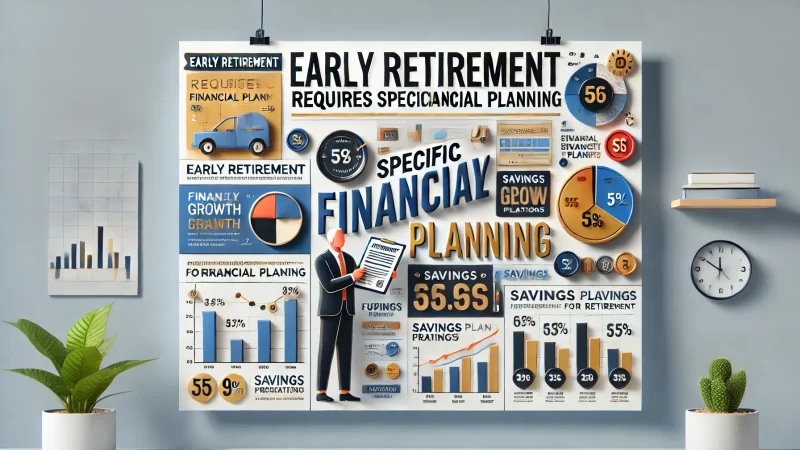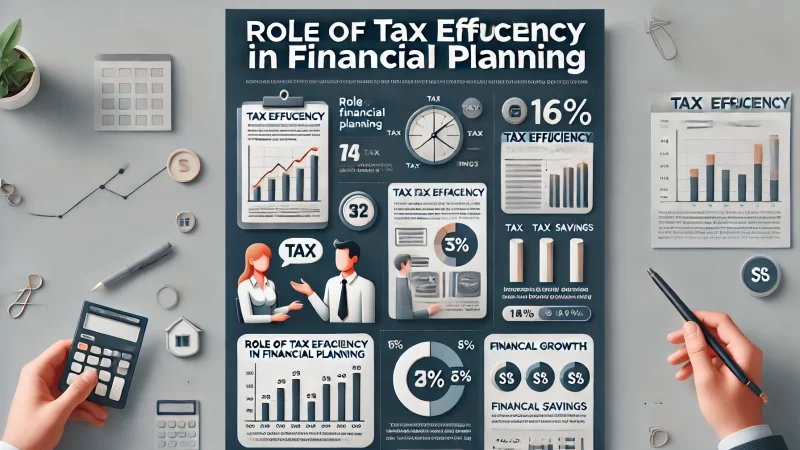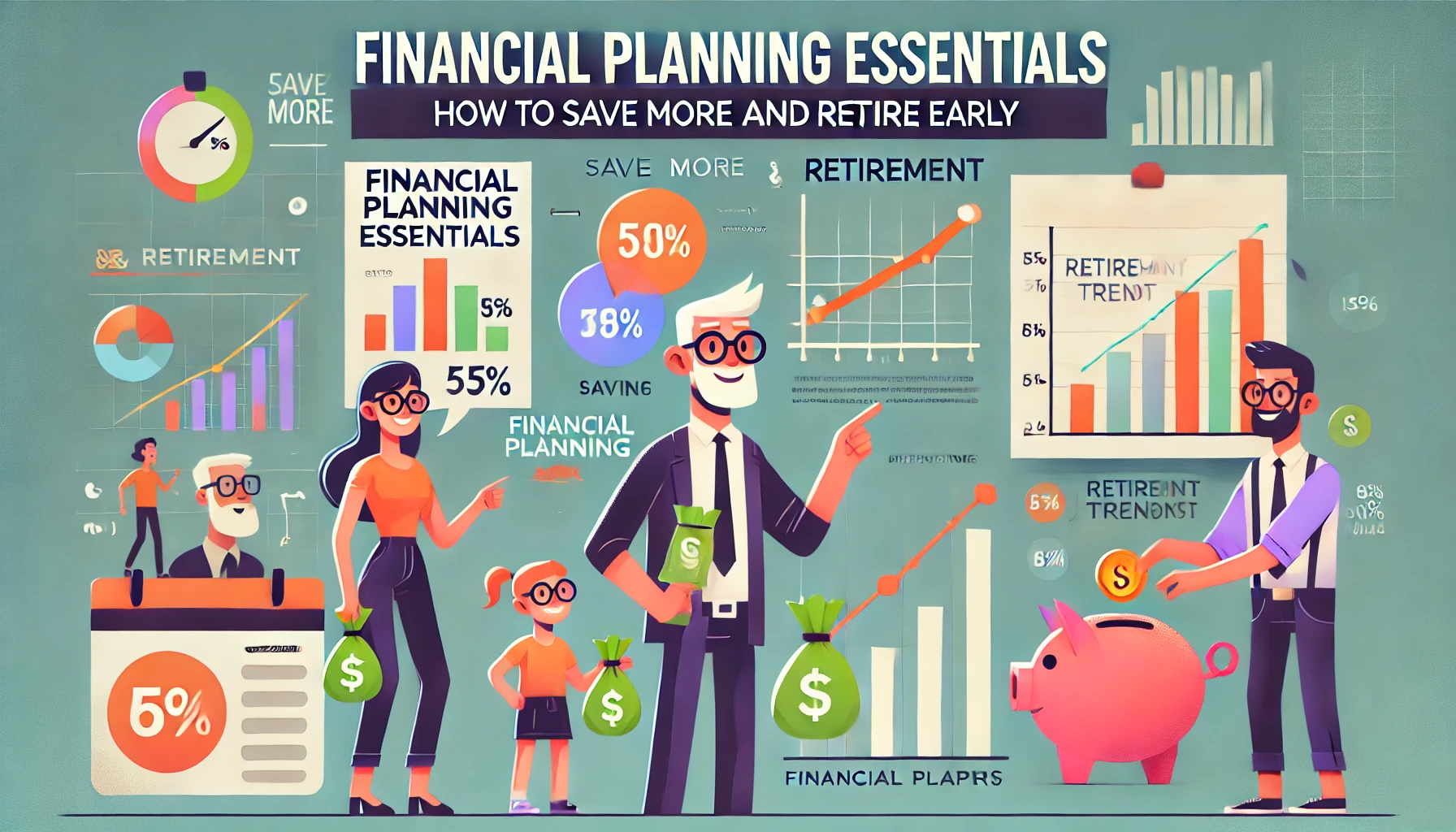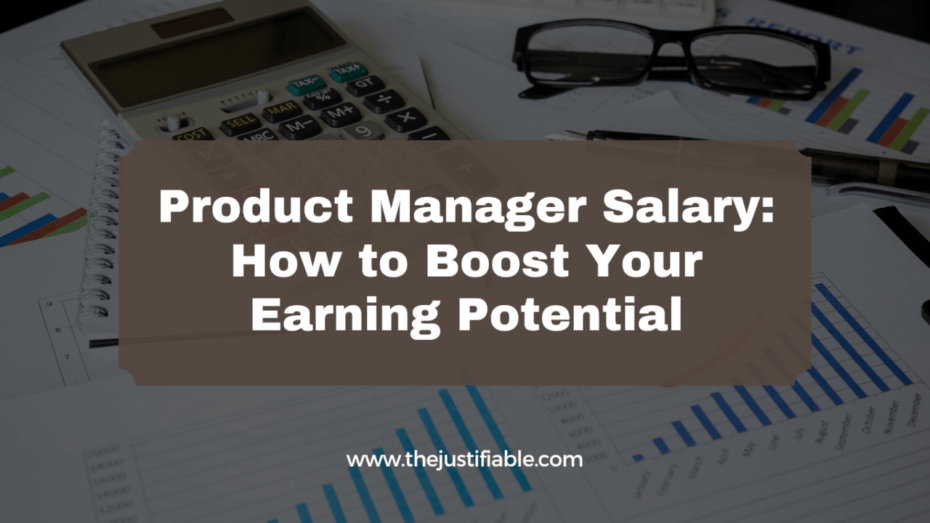Table of Contents
Are you wondering how to save more and retire early? Many people ask this question as they begin their financial planning journey, seeking ways to balance savings, investment strategies, and early retirement goals.
In this article, we’ll dive deep into the essentials of financial planning, offering practical insights on how to optimize your finances and achieve financial independence ahead of schedule.
What Are The Core Principles Of Effective Financial Planning?
Effective financial planning begins with understanding key principles that guide your financial decisions. These core principles are essential in helping you achieve long-term financial security.
I always advise starting with a solid plan that aligns with your personal goals. Without proper planning, it’s easy to lose track of your finances.
Another essential principle is consistency. Financial planning requires ongoing effort, from budgeting to tracking your progress. It’s crucial to remain disciplined and regularly reassess your financial situation. I’ve noticed that those who stick to their plan over time are the most successful in reaching their financial goals.
Defining Financial Goals and Priorities
The first step in any financial planning journey is defining your financial goals. What are you saving for? Is it retirement, a house, or your children’s education? I find that clarifying these goals helps you set a clear roadmap. It’s easier to save and invest when you know exactly what you’re working toward.
I always suggest separating short-term and long-term financial priorities. Short-term goals could include paying off debt, while long-term objectives might focus on retirement planning. This division allows you to manage your finances more effectively, giving each goal the attention it deserves.
Once you’ve defined your priorities, break them into actionable steps. I often tell people that large financial goals can seem overwhelming. But, when broken down into smaller, achievable milestones, they become more manageable. This way, you’re less likely to become discouraged.
Another thing to keep in mind is flexibility. Life is unpredictable, and financial goals may change. I recommend reviewing and adjusting your goals periodically. This ensures your financial plan remains relevant and aligned with your current needs.
Finally, remember to celebrate small wins. When you reach a savings milestone or pay off a significant portion of debt, take a moment to acknowledge your progress. It’s a great motivator and reminds you that you’re on the right track toward financial freedom.
Understanding The Importance of Budgeting
Budgeting is the foundation of any successful financial plan. Without a budget, it’s impossible to know where your money is going. I often emphasize to people that a budget is not restrictive; it’s empowering. It gives you control over your finances and allows you to make informed decisions.
Creating a budget doesn’t have to be complicated. Start by listing your monthly income and expenses. Once you have a clear view of your financial landscape, you can identify areas where you can cut costs and save more. I’ve found that small adjustments can make a big difference over time.
One trick I recommend is the 50/30/20 rule. Allocate 50% of your income to necessities, 30% to discretionary spending, and 20% to savings and debt repayment. This balanced approach ensures you’re meeting your needs while still working toward financial growth.
Remember, a budget isn’t set in stone. I always advise reviewing your budget regularly. Life changes, and so do your financial circumstances. Adjusting your budget allows you to stay on track, no matter what new expenses or opportunities arise.
Lastly, stay consistent. Tracking your spending every month helps you avoid overspending and ensures you’re meeting your financial goals. I’ve found that those who consistently follow their budget achieve better financial outcomes in the long run.
Building a Strong Financial Foundation
A strong financial foundation is built on saving, investing, and protecting your wealth. The first building block is an emergency fund. I suggest setting aside at least three to six months’ worth of living expenses. This fund will cover you in case of unexpected financial emergencies.
Another critical component is insurance. I believe that adequate health, life, and disability insurance protect your financial well-being. These safeguards prevent you from dipping into your savings or investments when faced with a sudden expense, ensuring your financial foundation remains solid.
Once you’ve secured your emergency fund and insurance, focus on paying off high-interest debt. I’ve seen many people struggle to build wealth because of lingering debt. Prioritize paying it off so you can redirect those funds toward investments that grow your financial future.
In terms of investing, I suggest starting early. Time in the market is one of the most significant factors in wealth accumulation. Even small contributions to a retirement account, like a 401(k) or IRA, can grow substantially over time through the power of compounding.
Lastly, build good financial habits. Automating your savings and investments ensures you’re consistently building wealth without relying on willpower. I’ve noticed that people who automate their financial decisions are more likely to stay on track toward their long-term goals.
Avoiding Common Financial Planning Mistakes
One of the most common financial planning mistakes is failing to plan for the future. I’ve seen individuals focus only on immediate expenses, leaving little room for long-term goals like retirement. To avoid this, I suggest creating a balanced plan that addresses both short- and long-term financial needs.
Another mistake is underestimating the impact of debt. High-interest credit card debt can derail even the best financial plans. I advise paying down high-interest debt as quickly as possible to free up resources for saving and investing.
Overspending on lifestyle is another pitfall. I’ve noticed that people often increase their spending as their income grows. This can lead to financial strain. I recommend maintaining a modest lifestyle, even as your income increases, to ensure you have more to save and invest.
Not seeking professional help is another error. I believe that financial advisors provide valuable insight, especially for complex financial situations. They can help you avoid costly mistakes and ensure your plan aligns with your long-term goals.
Finally, neglecting to review and adjust your financial plan regularly is a significant mistake. Your financial situation will change over time, and your plan needs to adapt. I always recommend a yearly review to keep your goals, savings, and investments on track.
How To Create A Practical Financial Plan For Saving More

Saving more requires a practical approach to managing your finances. I recommend starting with a clear savings goal in mind. Whether it’s for a vacation, a down payment on a home, or early retirement, knowing what you’re saving for can boost your motivation.
Once you have a goal, it’s time to build a plan around it. I’ve found that by creating a detailed financial plan, which includes specific monthly savings targets and strategies for balancing spending, you can achieve even the most ambitious savings goals.
Calculating Monthly Savings Targets
The key to saving more is setting realistic, achievable savings targets. I advise calculating how much you need to save each month to reach your goal within your desired timeframe. This provides you with a clear target and makes it easier to monitor your progress.
I suggest considering both your income and expenses when calculating savings. If you’re spending more than you’re earning, it’s time to make some adjustments. I find that by tracking spending and identifying areas to cut back, you can free up more money for savings.
Another trick I recommend is automating your savings. By setting up automatic transfers to your savings account, you’ll save without even thinking about it. I’ve noticed that this strategy makes it easier to stick to your savings goals consistently.
As your income increases, so should your savings. I always suggest adjusting your savings targets whenever you receive a raise or bonus. This ensures that your savings grow in line with your financial success, helping you reach your goals faster.
Finally, I recommend celebrating milestones. When you reach a significant savings target, take a moment to recognize your progress. This positive reinforcement helps keep you motivated and focused on your long-term goals.
Balancing Debt Repayment And Savings
Balancing debt repayment and savings can be tricky, but it’s essential for financial stability. I recommend tackling high-interest debt first, as it can quickly eat into your income. By focusing on paying off debt, you’ll have more money to allocate toward savings in the long run.
While paying off debt, I advise not neglecting your savings. I’ve found that saving even a small amount each month can help you build an emergency fund and provide a financial cushion. This can prevent you from accumulating more debt in the future.
I suggest creating a debt repayment plan that works for your budget. By prioritizing high-interest debt and making minimum payments on lower-interest obligations, you can free up funds to increase your savings. This approach balances debt reduction with future financial growth.
Once your high-interest debt is under control, I recommend reallocating the funds you were using for debt repayment to your savings. This helps you accelerate your savings progress without drastically changing your spending habits.
Lastly, avoid taking on new debt unless absolutely necessary. I always advise people to live within their means, which helps you avoid falling into a cycle of debt that hinders your ability to save.
Maximizing Income Streams for Greater Savings
Boosting your income is one of the best ways to save more. I always suggest exploring side hustles or freelance opportunities to supplement your primary income. With additional income streams, you’ll have more money to dedicate to savings and investments.
Another strategy I recommend is negotiating a raise at your current job. I’ve found that many people overlook this option. However, by showcasing your value to your employer, you may be able to increase your salary, which boosts your savings potential.
I also suggest diversifying your investments to generate passive income. Investing in dividend-paying stocks or rental properties can create additional income streams that don’t require ongoing effort. I’ve seen many people accelerate their savings by reinvesting this passive income.
If you’re self-employed, I recommend increasing your rates or expanding your services. By enhancing the value you offer to clients, you can command higher fees, which directly impacts your savings. I’ve seen this work effectively for freelancers and business owners alike.
Finally, cut unnecessary expenses and direct those funds to your savings. I suggest reviewing your monthly expenses and identifying areas where you can reduce costs, such as subscriptions or dining out. These small changes can significantly boost your savings over time.
What Are The Best Strategies For Growing Your Savings?

Growing your savings requires a strategic approach. I recommend focusing on methods that maximize your returns while minimizing risk. By diversifying savings options, you can ensure a steady growth rate over time. It’s not just about stashing money away but making your savings work for you through smart, calculated decisions.
Additionally, you should continually review and adjust your savings strategies as your financial goals evolve. I always suggest reassessing your financial situation annually to ensure your savings strategies align with your long-term objectives. This ongoing process helps you stay on course while capitalizing on new opportunities.
High-Yield Savings Accounts Vs. Traditional Accounts
Choosing between high-yield and traditional savings accounts can significantly impact your savings growth. I recommend high-yield accounts because they typically offer better interest rates. Even though they come with some restrictions, they allow your money to earn more over time, which is crucial for long-term savings.
While traditional savings accounts are more flexible, they often offer very low interest rates. If you’re focused on growing your savings, I suggest only using traditional accounts for short-term financial needs. You’re not going to see much growth in these accounts, but they do offer easy access to funds when needed.
I advise reviewing the terms of each account type carefully. High-yield accounts may limit how frequently you can withdraw, so I find they’re best for long-term savings goals. On the other hand, traditional accounts offer more liquidity, making them useful for emergency funds.
One of the biggest advantages of high-yield savings accounts is compounding interest. I’ve noticed that even modest interest rates can make a significant difference over time, especially when you’re disciplined about regular contributions. This compounding effect amplifies your savings efforts, giving you more financial flexibility.
Lastly, I recommend using both account types strategically. By maintaining a traditional account for immediate expenses and a high-yield account for savings, you can enjoy the benefits of both without sacrificing flexibility or growth potential.
Leveraging Investments To Increase Wealth
Investing is one of the most effective strategies for growing your savings. I believe the earlier you start investing, the more time your money has to grow through compound interest. Even small contributions to a retirement or brokerage account can accumulate substantial wealth over time, making investments key to financial success.
When choosing investments, I suggest diversifying your portfolio. Spread your money across various asset classes like stocks, bonds, and real estate. This reduces risk while giving you multiple avenues for growth. I’ve seen many people achieve financial security by leveraging a balanced, diversified investment approach.
Risk tolerance plays a critical role in investment decisions. I advise evaluating your comfort with risk before choosing specific investments. Those with a higher risk tolerance may lean toward stocks, which can offer higher returns. For more conservative savers, I recommend bonds or index funds, which provide steady, lower-risk growth.
Reinvesting dividends is another powerful strategy. I’ve heard from many investors who use dividend payments to purchase more shares, further compounding their wealth. This creates a snowball effect, where your returns continually increase, helping you reach your savings goals faster.
I also emphasize the importance of regular contributions. Even during market downturns, continuing to invest consistently helps you capitalize on market rebounds. Over time, this disciplined approach has proven to yield strong financial returns for those committed to growing their wealth through investments.
Passive Income Strategies For Consistent Savings Growth
Passive income is an excellent way to grow your savings without constantly trading time for money. I suggest exploring various passive income opportunities like rental properties, dividend-paying stocks, or interest from peer-to-peer lending. These strategies allow you to build wealth while focusing on other aspects of life.
One of the easiest ways to generate passive income is through dividend stocks. I’ve found that investing in companies that pay dividends offers steady returns over time. These dividends can be reinvested, compounding your wealth and accelerating your savings growth with minimal effort.
Another popular method is real estate investing. While it requires an initial investment, rental properties can provide consistent cash flow. I believe that, if managed well, rental income can significantly boost your savings while offering potential appreciation in property value.
I also recommend looking into peer-to-peer lending platforms. These allow you to earn interest by lending money to others. Although it carries some risk, I’ve noticed that peer-to-peer lending can offer higher returns than traditional savings methods, making it a viable passive income option for increasing your savings.
Lastly, creating digital products like e-books or courses is a way to generate passive income. Once developed, these products can be sold repeatedly, offering consistent revenue without ongoing work. This approach requires upfront effort but has the potential for long-term financial rewards.
Why Early Retirement Requires Specific Financial Planning

Early retirement isn’t just about saving money; it requires specific financial planning to ensure your savings will last. I always advise creating a detailed plan that accounts for the longer retirement period, healthcare costs, and inflation. Without this foresight, you may risk running out of money prematurely.
Additionally, I recommend taking a conservative approach to early retirement. While it’s tempting to focus solely on saving aggressively, you must also ensure your savings are protected against potential financial risks. This balance between growth and preservation is crucial for a secure, comfortable early retirement.
Projecting Retirement Needs Based on Lifestyle Goals
I always emphasize the importance of accurately projecting your retirement needs. This involves calculating how much you’ll need based on your lifestyle goals. Are you planning to travel extensively, or will you live a more modest lifestyle? The answer dramatically impacts how much you should be saving for retirement.
A good rule of thumb is to estimate that you’ll need around 80% of your pre-retirement income to maintain your current lifestyle. I’ve found that using this guideline gives you a clearer target, helping you plan accordingly and ensuring you don’t fall short during retirement.
Another factor to consider is longevity. People are living longer, which means your savings need to last. I advise planning for at least 30 years in retirement. This may require increasing your contributions now to ensure you have enough funds to support your desired retirement lifestyle.
Healthcare is another major expense in retirement. I recommend factoring in potential healthcare costs, which can quickly eat into your retirement savings. This includes insurance premiums, out-of-pocket expenses, and long-term care, all of which should be part of your retirement budget.
Finally, don’t forget about taxes. I always advise planning for taxes on retirement income, whether it’s from Social Security, pension plans, or withdrawals from tax-deferred accounts. By understanding how much you’ll owe, you can better project how much you’ll need to save for a comfortable retirement.
Estimating Healthcare Costs In Early Retirement
Healthcare is one of the biggest expenses in retirement, especially for those retiring early. I recommend estimating these costs as part of your financial planning. Early retirees often need private health insurance until they qualify for Medicare, and I’ve found that premiums can be quite high.
In addition to premiums, I suggest accounting for out-of-pocket medical costs. These expenses can include prescriptions, doctor visits, and emergency medical care. I believe that overestimating healthcare costs is better than underestimating, as it’s always better to have a financial cushion.
Another important factor is long-term care. Many early retirees overlook the potential cost of assisted living or nursing home care. I advise planning for this possibility, as long-term care can quickly deplete your savings if not accounted for in advance.
To offset some of these costs, I recommend looking into health savings accounts (HSAs). I’ve noticed that HSAs offer tax advantages and allow you to save for medical expenses on a tax-deferred basis. They’re a great tool for those planning to retire early.
Lastly, stay healthy! Preventative care can significantly reduce your medical expenses over time. I always advise focusing on maintaining a healthy lifestyle to reduce the need for costly medical treatments later in life, preserving your savings for other retirement needs.
How Inflation Impacts Retirement Savings Over Time
Inflation can erode your purchasing power during retirement, making it critical to plan for. I suggest using a higher-than-average inflation rate in your financial projections to account for rising costs. While it’s often overlooked, inflation can dramatically reduce the value of your savings.
One way to combat inflation is by investing in assets that outpace it. I recommend incorporating stocks into your retirement portfolio, as they historically provide higher returns that exceed inflation rates. This ensures your savings grow in real terms over time.
Another tool I often recommend is Treasury Inflation-Protected Securities (TIPS). TIPS are designed to increase in value along with inflation, offering a safe way to protect your savings. These bonds can serve as a hedge against rising prices during retirement.
You should also consider the inflation impact on specific expenses like healthcare. I’ve noticed that healthcare costs often rise faster than general inflation. Planning for these higher-than-average increases ensures your retirement savings won’t be depleted prematurely.
Finally, maintain flexibility in your retirement plan. I suggest reviewing your savings and investments regularly to adjust for inflationary changes. By staying proactive, you can ensure that inflation doesn’t negatively impact your retirement lifestyle.
How To Minimize Financial Risks As You Save And Invest
Minimizing financial risk is crucial for preserving your savings. I suggest diversifying your investments to spread risk across multiple asset classes. By balancing high- and low-risk investments, you can protect your savings while still enjoying growth potential. This strategy ensures long-term financial security without unnecessary risk.
Additionally, I recommend regularly reviewing your financial plan to identify potential risks early. As life changes, your financial risks may evolve, and staying aware of them helps you make proactive adjustments to your savings and investment strategies. This approach prevents financial surprises that could otherwise derail your progress.
Diversifying Your Investment Portfolio
Diversification is a key strategy in managing risk. I recommend spreading your investments across various asset classes, such as stocks, bonds, and real estate. This reduces your exposure to any single market downturn, ensuring that if one investment performs poorly, others can compensate.
I often suggest including international investments in your portfolio. These can provide additional diversification and growth opportunities. Global markets may perform differently than domestic ones, giving you more protection and potential returns in different economic environments.
Another way to diversify is through mutual funds and ETFs. I’ve found that these investment vehicles offer exposure to a wide range of assets without requiring significant upfront capital. This makes them a practical choice for those seeking diversification without taking on excessive risk.
I also recommend periodically rebalancing your portfolio. Over time, some investments may outperform others, causing your asset allocation to shift. By rebalancing, you can maintain your desired risk level and ensure that your portfolio remains aligned with your financial goals.
Lastly, consider your time horizon when diversifying. If you have a longer investment horizon, you may be able to take on more risk. However, for short-term goals, I suggest a more conservative approach to protect your savings from market volatility.
Assessing Risk Tolerance Before Making Financial Decisions
Understanding your risk tolerance is essential when planning your savings and investments. I recommend taking time to reflect on how comfortable you are with market fluctuations. If you can’t sleep at night due to market volatility, it’s a sign that you may need to adjust your investment strategy.
One method I suggest for gauging risk tolerance is imagining how you’d feel if your investments lost 20% in value. If this scenario causes anxiety, you may prefer a more conservative investment approach. I believe that aligning your investments with your comfort level helps prevent emotional decision-making during market downturns.
I also advise balancing your financial goals with your risk tolerance. If your goal is long-term wealth accumulation, you may be able to take on more risk. However, for short-term goals, I find that a lower-risk approach, such as bonds or savings accounts, can provide more security.
Regularly reassess your risk tolerance as you age. I’ve noticed that many people become more conservative as they near retirement, focusing on preserving their wealth. Adjusting your investment strategy accordingly ensures that you’re prepared for this shift in financial priorities.
Lastly, consult with a financial advisor if you’re unsure of your risk tolerance. Advisors can provide personalized guidance based on your financial goals and situation, helping you make informed decisions that align with your comfort level and objectives.
Emergency Funds: Their Role In Reducing Financial Risk
An emergency fund is your financial safety net, protecting you from unforeseen expenses. I always recommend having three to six months’ worth of living expenses saved in a liquid account. This fund is crucial for covering unexpected costs like medical bills, car repairs, or job loss without needing to dip into your investments.
I suggest keeping your emergency fund separate from your investment accounts. By doing this, you ensure that you won’t have to sell investments at a loss during a market downturn to cover emergency expenses. Keeping these funds liquid gives you immediate access when you need it most.
I’ve found that many people underestimate the importance of an emergency fund. Without one, you may be forced to rely on credit cards or loans, leading to debt that could derail your financial progress. I advise prioritizing building this fund before making significant investment contributions.
It’s also important to periodically adjust the size of your emergency fund. As your financial situation or living expenses change, I recommend reviewing your emergency savings to ensure it’s adequate. This ongoing evaluation helps maintain your financial safety net in line with your current needs.
Finally, avoid tapping into your emergency fund for non-urgent expenses. I advise using this money only for true emergencies. Keeping your fund intact ensures that you’re prepared for the unexpected, preserving both your savings and long-term financial stability.
What Role Does Tax Efficiency Play In Financial Planning?

Tax efficiency plays a crucial role in maximizing your financial outcomes. I believe that structuring your investments and income streams in a tax-efficient manner helps you keep more of your hard-earned money. It’s about making strategic choices to reduce unnecessary tax burdens, allowing your savings to grow faster over time.
The key to tax efficiency is understanding how different types of accounts and investments are taxed. I suggest regularly reviewing your portfolio to ensure it’s optimized for tax efficiency. By making small adjustments, you can improve your overall financial situation and move closer to your long-term financial goals.
Understanding Tax-Deferred Accounts and Their Benefits
Tax-deferred accounts, like 401(k)s and IRAs, allow you to delay paying taxes on contributions and earnings until you withdraw the funds. I’ve found that this gives your money more time to grow, as taxes aren’t eating into your investment gains during the accumulation phase. It’s a smart way to boost your retirement savings.
I advise contributing as much as possible to tax-deferred accounts, especially if your employer offers matching contributions. This match is essentially free money and can significantly accelerate your savings growth. The tax deferral, combined with compounding interest, creates a powerful wealth-building tool.
While tax-deferred accounts offer substantial benefits, it’s important to remember that you’ll need to pay taxes upon withdrawal. I recommend planning your withdrawals carefully in retirement to avoid triggering higher tax brackets. This ensures you minimize your tax liability and keep more of your savings.
Another advantage of tax-deferred accounts is their ability to lower your taxable income. I always emphasize that reducing your income in the short term can help you stay in a lower tax bracket, which is particularly useful for those with high earning potential. This strategy offers both immediate and long-term benefits.
Finally, take advantage of catch-up contributions if you’re over 50. I’ve heard from many people who increase their retirement savings later in life using these additional contributions. This helps you maximize your tax advantages as you approach retirement, giving you a stronger financial foundation.
Optimizing Your Income for Maximum Tax Efficiency
Optimizing your income for tax efficiency can help you retain more of your earnings. I suggest splitting your income across different types of accounts to take advantage of various tax treatments. For example, combining taxable, tax-deferred, and tax-free accounts can provide greater flexibility when managing taxes in retirement.
Another tip I recommend is deferring bonuses or income into the following year if you’re close to moving into a higher tax bracket. This strategy can reduce your taxable income in the current year, allowing you to avoid additional taxes while maintaining a steady flow of earnings.
Income shifting can also be an effective tactic. I’ve seen individuals transfer income-generating assets to family members in lower tax brackets. This reduces the overall family tax burden while allowing more assets to remain within the family. It’s a great strategy for those with significant income streams.
Consider tax-efficient charitable donations as well. Donating appreciated securities instead of cash allows you to avoid capital gains taxes while still claiming a charitable deduction. I find that this approach maximizes the tax benefit while supporting causes you care about, offering a win-win scenario.
Lastly, review your income sources annually to ensure you’re not missing out on tax-saving opportunities. I often advise making minor adjustments based on current tax laws to optimize your strategy year after year. This continuous assessment ensures you’re always positioned to minimize your tax obligations.
How To Reduce Taxes On Investments and Retirement Accounts
Reducing taxes on investments requires a proactive approach. I always advise holding investments in tax-advantaged accounts like Roth IRAs to avoid paying taxes on future withdrawals. Roth accounts are funded with after-tax dollars, so any growth is tax-free, providing significant long-term savings.
Another method to consider is tax-loss harvesting. If some investments lose value, I recommend selling them to offset gains in other areas. This strategy reduces your taxable income while allowing you to reinvest the proceeds into new opportunities. I’ve seen this effectively lower tax burdens without disrupting overall financial goals.
It’s also important to hold investments for the long term. I often suggest focusing on long-term capital gains, as they’re taxed at lower rates than short-term gains. By holding investments for at least one year, you can reduce the tax impact on your portfolio while benefiting from potential growth.
Additionally, be mindful of dividend-paying stocks. I recommend prioritizing qualified dividends, as they’re taxed at a lower rate compared to ordinary income. This helps you keep more of your earnings while still enjoying the benefits of a dividend-paying portfolio.
Finally, stay up-to-date on tax law changes. I suggest working closely with a financial advisor or tax professional to ensure your strategy is always in line with current tax regulations. They can provide insights into the best ways to reduce your tax burden on investments and retirement accounts.
How To Plan For A Comfortable Early Retirement
Planning for early retirement requires careful financial planning. I suggest focusing on building a sizable nest egg that can sustain you for a longer retirement period. This involves saving aggressively and investing strategically, allowing your money to grow while maintaining a comfortable lifestyle throughout retirement.
I always recommend accounting for factors like healthcare costs and inflation when planning for early retirement. These often-overlooked expenses can significantly impact your financial security. With the right planning, you can retire earlier and still enjoy peace of mind, knowing that your finances are secure.
Setting Up Retirement Income Streams
Having multiple income streams in retirement is essential for financial stability. I suggest setting up a combination of sources like Social Security, pensions, and personal savings. These streams provide regular income, helping you cover living expenses without depleting your savings too quickly.
One effective income strategy I’ve seen is using annuities. Annuities provide guaranteed income for life, ensuring that you never run out of money. While they aren’t for everyone, I believe they offer peace of mind, especially for those concerned about outliving their retirement savings.
Another option I recommend is dividend-paying stocks. By investing in a portfolio of high-dividend stocks, you can generate a steady stream of income. This approach allows you to grow your investments while still receiving regular payments, which can supplement other retirement income sources.
Rental income is another powerful income stream. I’ve seen retirees generate significant cash flow from rental properties, providing a reliable source of income. If you’re comfortable managing real estate, this can be an excellent addition to your retirement plan, offering both income and potential appreciation.
Lastly, consider withdrawing from your retirement accounts strategically. I advise taking distributions from taxable accounts first, followed by tax-deferred accounts, and saving tax-free accounts for last. This approach minimizes taxes and helps your savings last longer.
Planning Social Security Benefits Early
Timing your Social Security benefits is crucial for maximizing lifetime income. I always recommend evaluating when to start taking benefits. While you can begin as early as age 62, waiting until full retirement age or later increases your monthly payments, which can make a big difference in your overall income.
I suggest considering your health and life expectancy when deciding when to claim Social Security. If you’re in good health and expect to live longer, delaying benefits may provide more financial security. I’ve seen many people benefit from this strategy, as higher payments offer long-term peace of mind.
Another tip I recommend is coordinating with your spouse. If both partners are eligible for benefits, I advise delaying the higher earner’s benefit as long as possible. This maximizes the surviving spouse’s benefit in the future, providing more financial support for the long term.
Additionally, be mindful of tax implications. Social Security benefits can be taxed if your income exceeds certain thresholds. I always suggest working with a tax advisor to plan for these taxes, ensuring you don’t face unexpected financial burdens during retirement.
Finally, consider alternative income sources while delaying Social Security. I recommend using personal savings or part-time work to bridge the gap. This allows your Social Security benefits to grow while still providing for your financial needs in the interim.
Managing Expenses Efficiently During Early Retirement
Efficient expense management is critical for making your savings last during early retirement. I suggest creating a detailed budget that accounts for all living expenses, from housing to healthcare. This helps you avoid overspending and ensures your savings stretch over a longer retirement period.
I recommend prioritizing needs over wants when planning your budget. Focus on essential expenses first, such as housing, utilities, and food. I’ve seen that keeping discretionary spending in check during the early years of retirement helps prevent financial strain down the line.
Another strategy I advise is downsizing. Moving to a smaller home or a lower-cost area can significantly reduce your living expenses. Many retirees find that downsizing not only cuts costs but also simplifies their lifestyle, making it easier to manage expenses during retirement.
Healthcare costs are a major consideration. I recommend planning for Medicare and supplemental insurance, which can help cover unexpected medical expenses. By staying proactive about healthcare planning, you can avoid large, unplanned expenses that could deplete your savings.
Lastly, review your spending regularly. I’ve found that retirees who reassess their budget each year can catch overspending early and make adjustments. This keeps your expenses in line with your income, ensuring that your retirement savings remain sustainable.
What Are The Biggest Financial Planning Pitfalls To Avoid?
Avoiding common financial planning pitfalls can make or break your financial success. I always recommend staying aware of potential mistakes, such as underestimating the power of compound interest or overspending. By being mindful of these challenges, you can stay on track toward achieving financial independence and retiring early.
Another common pitfall is failing to adjust your financial plan as life changes. I suggest reviewing your financial goals and strategies regularly to ensure they remain aligned with your current situation. This proactive approach helps you avoid surprises and maintain financial security over time.
Ignoring The Impact Of Compound Interest
Compound interest is one of the most powerful tools in financial planning. I always recommend taking advantage of it by starting your savings and investments early. The longer your money has to grow, the more you’ll benefit from compounding, turning small contributions into substantial savings over time.
One mistake I’ve seen is underestimating the impact of compound interest on debt. High-interest debt can compound quickly, making it difficult to pay off. I suggest focusing on paying down high-interest debt first, so it doesn’t spiral out of control and sabotage your savings efforts.
Regular contributions to retirement accounts maximize the benefits of compound interest. I recommend automating your contributions to ensure consistency. By doing this, you’ll steadily grow your savings without needing to think about it. I’ve found that this strategy helps build wealth over the long term.
Another tip I offer is reinvesting dividends. I’ve noticed that reinvesting dividends into your portfolio accelerates the compounding process, allowing you to grow your investments faster. This small step can significantly impact your financial success in the long run.
Lastly, avoid interrupting the compounding process by withdrawing funds early. I recommend leaving your investments alone for as long as possible. Early withdrawals can severely limit your growth potential, reducing the overall benefits of compound interest.
Overspending Before You Reach Financial Independence
Overspending is one of the biggest obstacles to reaching financial independence. I always advise being mindful of lifestyle inflation, which occurs when your expenses increase as your income grows. Staying disciplined with your spending habits ensures you have more money to save and invest toward your goals.
I recommend tracking your spending closely. I’ve seen that those who regularly monitor their expenses are more likely to stay within their budget and avoid overspending. This simple habit helps you stay focused on your financial goals without sacrificing your quality of life.
Another pitfall I’ve noticed is using credit cards irresponsibly. While credit cards offer convenience, I advise paying off your balance in full each month. Accumulating credit card debt can lead to high-interest payments, which eat into your savings and slow your progress toward financial independence.
I also suggest setting limits on discretionary spending. By allocating a specific portion of your income to non-essential expenses, you’ll enjoy your lifestyle while still prioritizing saving. I find that this balance keeps you on track without feeling overly restricted.
Finally, stay focused on your long-term goals. I always emphasize that short-term spending can derail your financial independence plans. By keeping your eye on the prize and resisting unnecessary purchases, you’ll achieve financial freedom more quickly and enjoy a more secure future.
Failing To Reevaluate Your Financial Plan Regularly
A financial plan isn’t something you set once and forget. I recommend reevaluating your plan regularly to ensure it still aligns with your goals. Life changes, and so do your financial priorities. I’ve seen that regular reviews help keep your financial strategy on track, ensuring continued progress toward your objectives.
One common mistake is failing to account for changes in income. If your income increases, I suggest adjusting your savings rate accordingly. This helps you make the most of your financial situation without falling into the trap of lifestyle inflation, which can undermine your savings efforts.
I also recommend revisiting your investment strategy as you age. What worked in your 20s may not be suitable in your 50s. I’ve noticed that shifting toward more conservative investments as you near retirement helps protect your wealth while still allowing for moderate growth.
Another factor to consider is changes in tax laws. I always advise staying informed about tax regulations that may impact your financial plan. Adjusting your strategy to take advantage of tax-saving opportunities ensures you’re not leaving money on the table.
Finally, consider working with a financial advisor. I’ve found that a professional can provide valuable insights during financial reviews, helping you identify areas for improvement and stay on track toward your long-term goals.
How Can Financial Advisors Help You Save More And Retire Early?
Financial advisors play a key role in helping you save more and achieve early retirement. I recommend seeking professional advice, especially if your financial situation is complex. Advisors provide personalized guidance that aligns with your goals, helping you make informed decisions about savings, investments, and tax strategies.
Additionally, financial advisors can offer valuable insights that you may overlook on your own. I always suggest consulting with an advisor periodically to review your progress and adjust your strategy as needed. Their expertise can make the difference between retiring comfortably and running out of money too soon.
Why Personalized Financial Advice Is Critical
Personalized financial advice ensures your plan fits your unique circumstances. I recommend working with a financial advisor who understands your specific goals, risk tolerance, and financial situation. This personalized approach helps you make decisions that are best suited to your needs, providing a tailored roadmap to financial success.
Advisors can help you identify opportunities for savings and investment that you might not have considered. I’ve found that many people overlook tax-saving strategies or fail to diversify their portfolios effectively. A financial advisor can help you optimize your financial plan for maximum efficiency and growth.
Additionally, advisors provide accountability. I believe that having someone review your progress regularly keeps you on track. They’ll ensure you’re meeting your financial milestones and make adjustments when necessary. This external support can be invaluable for staying disciplined with your savings and investments.
Personalized advice is especially important as you approach retirement. I recommend working with an advisor to fine-tune your retirement strategy, including withdrawal plans and income sources. This ensures you’re fully prepared for the next phase of life and won’t run out of money prematurely.
Lastly, personalized advice helps you navigate financial challenges. I’ve seen that people with advisors tend to make better financial decisions during market downturns or unexpected life events. Having expert guidance ensures you’re not making emotional choices that could harm your long-term financial health.
Choosing The Right Financial Advisor For Your Goals
Choosing the right financial advisor is critical to your success. I always recommend finding someone with experience in your specific financial needs, whether that’s retirement planning, investments, or estate planning. A good fit ensures the advisor understands your goals and can provide relevant, actionable advice.
Look for a fiduciary advisor. I suggest working with someone legally obligated to act in your best interest. This eliminates potential conflicts of interest and ensures that the advice you receive is focused solely on helping you achieve your financial objectives.
I also recommend checking the advisor’s credentials. I find that professionals with certifications like CFP (Certified Financial Planner) or CFA (Chartered Financial Analyst) are well-equipped to provide expert advice. These credentials indicate that the advisor has undergone rigorous training and adheres to ethical standards.
Another factor to consider is the advisor’s fee structure. I advise choosing an advisor with a transparent fee structure, whether that’s a flat fee, hourly rate, or percentage of assets under management. Understanding how your advisor is compensated helps you avoid surprises and ensures alignment with your financial goals.
Finally, trust your instincts. I always tell people to work with an advisor they feel comfortable with. Financial planning is a long-term relationship, so it’s important to choose someone who listens, communicates clearly, and aligns with your values and objectives.
What To Expect From A Financial Advisor For Early Retirement
A financial advisor can play a crucial role in your early retirement plan. I suggest working with an advisor who specializes in early retirement to help you navigate the unique challenges it presents. They’ll assist in projecting your retirement needs, estimating healthcare costs, and optimizing income streams to ensure financial security.
Expect your advisor to create a detailed plan that accounts for the longer retirement period. I’ve found that early retirees need to be especially mindful of inflation, healthcare, and investment risks. Your advisor will help you balance these factors while still allowing for growth in your retirement savings.
I recommend asking your advisor about strategies for tax-efficient withdrawals. Early retirees often face different tax challenges, and a knowledgeable advisor can help you minimize your tax burden during this phase of life. This ensures you keep more of your savings for essential expenses.
Your advisor should also assist in managing your investment portfolio during retirement. I suggest working with them to adjust your asset allocation as needed. By reducing risk while still allowing for moderate growth, you can protect your savings without missing out on potential income.
Lastly, expect ongoing support. Early retirement requires regular financial check-ins to ensure you’re staying on track. I believe that working closely with your advisor throughout retirement provides peace of mind, knowing that your financial future is secure.






